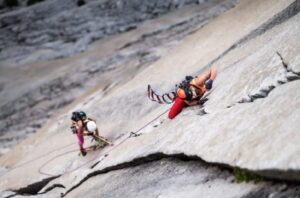Hiking up Mount Fuji is more of a traveling experience than a mountain climb. That may be part of the appeal of the iconic Japanese volcano for the hundreds of thousands that line its slopes every summer. However, this human pressure has proven too much for the mountain, forcing authorities to establish limits this year. But those limits might not be enough.
Seventy days, 300,000 visitors
Mount Fuji is the highest peak in Japan. A sacred mountain with a snow-capped summit like icing cake on its perfectly conical shape, it is perhaps the most popular landmark in the country. The climbing season lasts from July 1 and spans 70 days, until mid-September. Authorities close the peak to tourists for the rest of the year.
This window bunches visitors together, including mountaineers and tourists aiming for summit views, but also locals and Shintoist pilgrims. Around 300,000 people climb Fuji each year and 30% of them are foreigners, according to Japonpedia.
Unsurprisingly, the trip is far from lonely. The Yoshida Trail is especially busy. It’s the easiest and most crowded of Fuji’s four official routes. While the ascent is divided into 10 stations (mountain refuges with facilities and food), most people start walking from the fifth station, located at 2,305m. This is the last station reachable by public transport. From that point, expect to walk in line at all times along the black rock trail to the top.
On the summit, in addition to the crater rim, you’ll find a ramen service and a post office.
Those looking for open space and a full mountain experience will probably be disappointed. Several travel guides quote a Japanese saying: “It is stupid not to climb Mount Fuji once in a lifetime, but it is even more stupid to climb it twice.”

The idyllic images of a calm, snow-capped Mt. Fuji are quite different from most people’s experience of crowds and rocky terrain at the summit, like on this day in August. Photo: Shutterstock
Limited, to 4,000 a day
Yamanashi prefecture authorities will now impose a toll (they will decide the amount later this month) and will limit the number of climbers per day up the Yoshida Trail to 4,000, Times of India reported.
Climbers will no longer be allowed to start the walk between 4 pm and 2 am, a strategy employed to see the sunrise from the summit. Now, sunrise enthusiasts will need to try and find a free place in one of the crowded mountain huts along the way or to make sure they’re fast enough to reach the summit in time when starting at 2 am.
Yet, authorities are aware that these limitations will not be enough to improve the situation on the overcrowded mountain. Facilities such as paid toilets and mountain huts are insufficient for the daily flow of visitors. The number of sick and injured visitors grows every season and the waste disposal systems are overwhelmed. Further measures will be needed.






